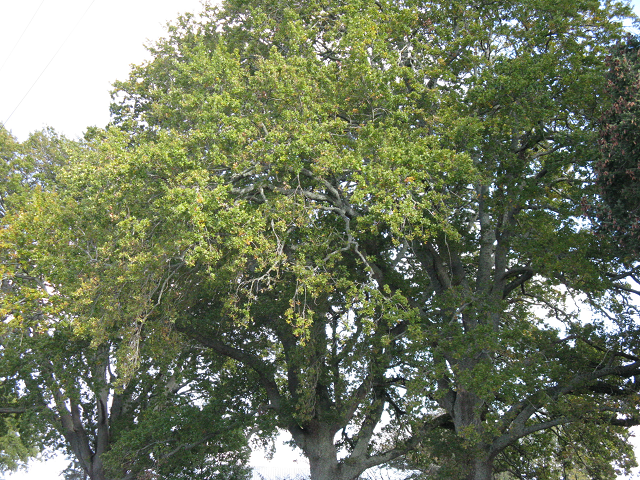
Quercus robur (Latin quercus, "oak" + robur "strength") is the species by which the oak genus is defined, and a member of the white oak section.
Quercus robur is a large deciduous tree, with circumference of grand oaks from 4 m to exceptional 12 m. The Majesty Oak with a circumference of 12.2 m is the thickest tree in Great Britain.
Quercus robur has lobed and very short-stalked leaves 7–14 cm long. Flowering takes place in mid spring, and the fruit, acorns, ripen by the following autumn. The acorns are 2–2.5 cm long, pedunculate (having an acorn-stalk, 3–7 cm) long) with one to four acorns on each peduncle.
Q. robur is very tolerant to soil conditions and the continental climate, but it prefers fertile and well-watered soils. Mature trees tolerate flooding.
It is a long-lived tree, with a large wide spreading crown of rugged branches. While it may naturally live to an age of a few centuries, many of the oldest trees are pollarded or coppiced, both pruning techniques that extend the tree's potential lifespan, if not its health. Two individuals of notable age are the Stelmuze Oak in Lithuania and the Granit Oak in Bulgaria, which are believed to be more than 1500 years old, possibly making them the oldraest oaks in Europe
Within its native range Q. robur is valued for its importance to insectsand other wildlife. Numerous insects live on the leaves, buds, and in the acorns. Q. robur supports the highest biodiversity of insect herbivores of any British plant (>400 spp). The acorns form a valuable food resource for several small mammalsand some birds, notably Eurasian jays. Jays were overwhelmingly the primary propagators of oaks before humans began planting them commercially (and still remain the principal propagators for wild oaks), because of their habit of taking acorns from the umbra of its parent tree and burying them undamaged elsewhere. Mammals, notably squirrels,who tend to hoard acorns and other nuts usually leave them too abused to grow in the action of moving or storing them.
A number of cultivarsare grown in gardensand parks. The most common cultivar is Quercus robur 'Fastigiata', and is the exception among Q. robur cultivars that are generally smaller than the standard tree, growing to between 10–15 m.

